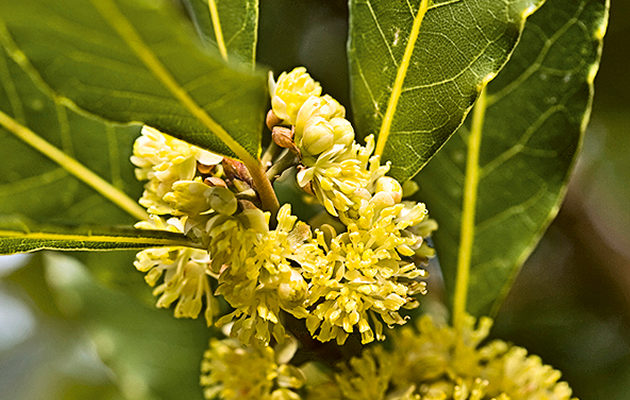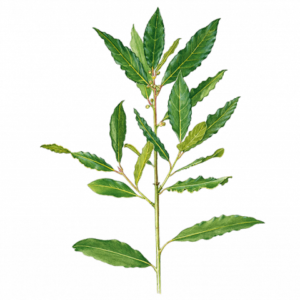
Find out more about the Bay plant of our Aromatherapy Herbarium blog series.

BAY
Laurus nobilis
DESCRIPTION

Bay (Laurus nobilis) is a perennial persistent foliage shrub with dark grey bark of the Laureaceae family. It includes two varieties, golden bay tree (Laurus nobilis aurea) and the narrow leaf bay tree (Laurus nobilis angustifolia). It is native to southern Europe and the Middle East and can sometimes reach six metres.
ADVICE
Essential oil of bay must be used diluted on the skin, after a skin test because it is allergenic and slightly dermocaustic. Oral administration requires a medical prescription. Beware of not exceeding the dose or prolonging the use of essential oil of bay as it could have a narcotic effect.
DO NOT USE IN
– pregnant or breast-feeding women,
– children under the age of three years.
– persons allergic to one of the components (geraniol, linalool, limonene),
– subjects with asthma without the advice of an allergologist before the first use.
RECIPES
Mouth ulcers
4 ml of EO of bay, 10 ml of rose hip CO.
Apply three times daily using a cotton swab on the mouth ulcer until healed over a maximum of seven days.
Recurrent colitis
Take twice daily for fifteen days, 2 drops of essential oil of bay and 1 drop of essential oil of cinnamon on a neutral tablet.
Hair growth
2 to 3 drops of bay leaf mixed with your usual dose of shampoo stimulate the scalp.

It is native to southern Europe and the Middle East and can sometimes reach six metres. Its leaves, like all other parts of the plant, are leathery, lanceolate with undulate edges and rich in essential oil. They grow in all soils in the Mediterranean regions. Sowing and cuttings are performed in the fall.
Like most Mediterranean plants, bay has its legend: Eros made Apollo fall madly in love with the nymph Daphne, as a revenge for making fun of him, and was the cruel enough to make the beauty insensitive to her divine suitor. Tired of fleeing, she was changed into a bay tree that Apollo who was still in love dedicated to peace, triumph and happiness. This is why the Romans waved bay branches as a sign of joy. In Rome and in Greece, winners were crowned with bay, as were students who succeeded their exams in the Middle Ages. Their head was crowed with bay leaves and berries (Bacca laurea) thus our “baccalaureate”. It is found in the very ancient recipe for “Aleppo soap” for skin care, and in Crete women have been using since time immemorial to give lustre to their hair. Its culinary merits are so well known that they hardly need to be restated.
CULTIVATION AND PRODUCTION
Bay grows all over the Mediterranean basin, in France, Italy, Spain, Greece and in the Balkans. Turkey is by far the first exporter, its culture brings it more than twenty million dollars every year. It is abundant in Corsica where traditionally a herbal tea was prepared for stomach pains. It is propagated by cuttings or layering in rich, drained and sandy soil.
FRAGRANCE
The odour of bay is both fresh, woody and spicy, similar to that of its crushed leaves.
EXTRACTION AND YIELD
The steam distillation of bay leaves has a very low yield of 0.13% of essential oil. One hundred kilograms of plant are required to obtain one hundred and thirty millilitres of essential oil.
CHEMICAL FORMULA
The active constituents of Laurus nobilis are principally monoterpenes, sesquiterpenes, monoterpenols (linalool), esters, phenols, oxides (1,8-cineol) and lactones (costunolide).
MAIN INDICATIONS
Essential oil of bay is antibacterial, antiviral and fungicidal. It treats winter respiratory diseases, mouth sores, neuralgias and all skin and intestinal infections (it re-equilibrates the intestinal flora) as well as others. Among other exploits, combined with tea tree it cures Candida albicans mycoses. It helps fight fatigue and nervous disequilibrium conditions, stimulates the scalp and even has the property of make eyelashes grow.


Leave a Comment